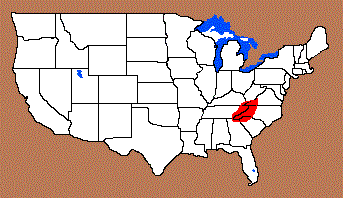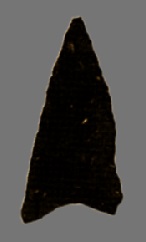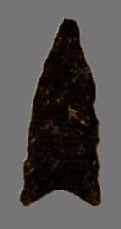Outline is Representative of Size and Shape: 

Name Details:
Identified By: Bennie C. Keel
Named For: Type Site
Date Identified: 1976
Type Site: The Garden Creek Mound, North Carolina
Identified By: Bennie C. Keel
Named For: Type Site
Date Identified: 1976
Type Site: The Garden Creek Mound, North Carolina
Point Validity:
Valid type
Keel is an anthropologist and professor at the University of North Carolina – Chapel Hill. He is considered an expert on southeastern archaeology and is dedicated to archaeological preservation. He was awarded the Lifetime Achievement Award in 2012 by the Society of American Archaeology. This type was named in a professional publication and has many professional references. This is considered a valid type.
Keel is an anthropologist and professor at the University of North Carolina – Chapel Hill. He is considered an expert on southeastern archaeology and is dedicated to archaeological preservation. He was awarded the Lifetime Achievement Award in 2012 by the Society of American Archaeology. This type was named in a professional publication and has many professional references. This is considered a valid type.
Garden Creek Triangular
Cluster: Late Woodland to Early Mississippian Triangle Cluster Description of Physical Characteristics and Flaking Pattern:
This is a medium(1.25 to 2.67 inches) isosceles triangle that is commonly three times the length as the width, with an elliptical cross section. The blade is primarily long and narrow with a straight edge that may vary from slightly excurvate to slightly incurvate. The base may vary from slightly concave to concave. The tip and basal corners are commonly sharp. This point has a random flaking pattern. This point is manufactured with direct percussion flaking and finished with fine pressure flaking along the edges.
Size Measurements:
Length - 31 to 68 mm (average 48 mm), Width - 21 to 29 mm (average 23 mm), Thickness - 5 to 10 mm, Basal Concavity - 3 to 6 mm (average 4 mm) (Keel, 1987)
Length - 31 to 68 mm (average 48 mm), Width - 21 to 29 mm (average 23 mm), Thickness - 5 to 10 mm, Basal Concavity - 3 to 6 mm (average 4 mm) (Keel, 1987)
Commonly Utilized Material:
Primarily quartzite followed by chert and slate to a lesser degree.
Primarily quartzite followed by chert and slate to a lesser degree.
Additional Comments:
Keel (1987), notes that this is similar to, only larger, than the Connestee Triangle. Keel feels that individual points of this type may be misclassified as Camp Creek or Greenville points.
Keel (1987), notes that this is similar to, only larger, than the Connestee Triangle. Keel feels that individual points of this type may be misclassified as Camp Creek or Greenville points.
Distribution:

Distribution Comments:
This point is primarily found in North Carolina and into Virginia.
This point is primarily found in North Carolina and into Virginia.
Age / Periods:
Date: 2,200 - 1,800 B.P.
Cultural Period: Middle Woodland
Glacial Period: Roman Warm
Culture:
Date: 2,200 - 1,800 B.P.
Cultural Period: Middle Woodland
Glacial Period: Roman Warm
Culture:
Age Details:
Similar Points:
Camp Creek, Caraway, Clarksville, Connestee, Fort Ancient, Hillsboro, Madison, Yadkin
Camp Creek, Caraway, Clarksville, Connestee, Fort Ancient, Hillsboro, Madison, Yadkin
Other points in this cluster / Related / Associated Points:
Pigeon Side Notch
Pigeon Side Notch



